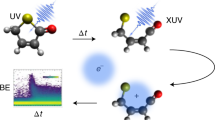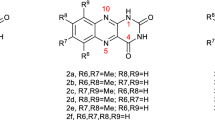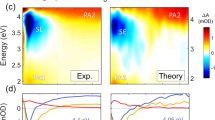Abstract
Over a wide range of pH, the semiquinone free radicals formed by reduction of adriamycin exist as a form which is strongly stabilised by internal hydrogen bonding and resonance. They protonate with pKa = 2.9. Below this pH they exhibit absorption maxima at 430 nm (Emax = 13,200 dm3 mol-1 cm-1) and approximately 720 nm (Emax = 4,200 dm3 mol-1 cm-1). Above pH 2.9 they have maxima at 480 nm (Emax = 14,600 dm3 mol-1 cm-1) and approximately 700 nm (Emax = 3,400 dm3 mol-1 cm-1). In acid and alkaline solution the radicals rapidly disappear by disproportionation, but within the approximate pH range 6 to 11 they appear to be relatively stable for at least 10-20 ms, existing in transient equilibrium with parent adriamycin and the full reduced form. Some rate constants for the formation and reactions of the semiquinone are given, including the reaction with oxygen to give O2.-. Fully reduced adriamycin has absorption maxima at 410 nm (Emax = 11,000 dm3 mol-1 cm-1) at pH 5 and 430 nm (Emax = 19,000 dm3 mol-1 cm-1) at pH 11. It undergoes decomposition within a few hundred ms. The intermediates from daunomycin would be expected to have properties similar to those from adriamycin.
This is a preview of subscription content, access via your institution
Access options
Subscribe to this journal
Receive 24 print issues and online access
$259.00 per year
only $10.79 per issue
Buy this article
- Purchase on Springer Link
- Instant access to full article PDF
Prices may be subject to local taxes which are calculated during checkout
Similar content being viewed by others
Rights and permissions
About this article
Cite this article
Land, E., Mukherjee, T., Swallow, A. et al. Possible intermediates in the action of adriamycin—A pulse radiolysis study. Br J Cancer 51, 515–523 (1985). https://doi.org/10.1038/bjc.1985.74
Issue Date:
DOI: https://doi.org/10.1038/bjc.1985.74
This article is cited by
-
Radiosensitization of thymine by Fe(III)-1,2 dihydroxyanthraquinone complex in dilute aqueous solution
Journal of Radioanalytical and Nuclear Chemistry Articles (1995)
-
Anthracycline antitumour agents
Pharmaceutisch Weekblad Scientific Edition (1986)
-
Applications of pulse radiolysis and flash photolysis to some problems related to the chemistry of cancer therapy
Journal of Radioanalytical and Nuclear Chemistry Articles (1986)



